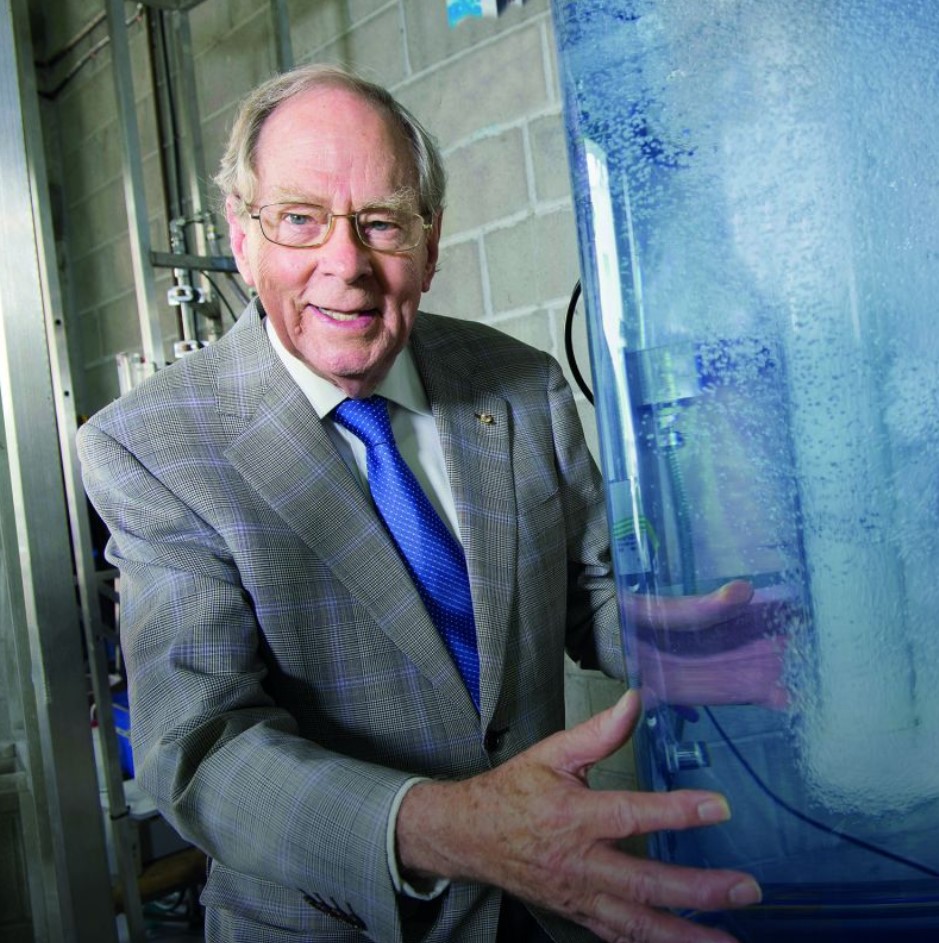
Trailblazing technology that’s delivering global impact
Emeritus Professor Graeme Jameson AO pioneered a lucrative minerals processing technology that has pumped billions of dollars into Australia’s economy and achieved global commercial success.
As a chemical engineer, Professor Jameson set out to develop a way to recover fine and highly valuable particles in minerals processing – particles that were traditionally discarded as waste. His solution sprouted from the froth flotation process, which was first used in an industrial setting in Broken Hill in the early 1900s.
Finding the solution began at the kitchen sink, where Professor Jameson observed the effect of a jet of tap water plunging into a water-filled basin. When fine bubbles were dispersing around the jet, it created a suitable shear rate, which is a measure of how quickly layers of fluid move past each other. The process could be likened to froth that’s created when squirting a hose into a bucket of detergent.
He used this observation to develop an improved froth flotation process in conjunction with mineral experts from Mount Isa Mines Limited – a subsidiary of MIM Holdings Limited, which was later acquired by Glencore Technology.
The result is the Jameson Cell, a process that uses high-pressure water jets to force tiny bubbles through a slurry of ground-up ore. The bubbles pick up fine mineral particles and can carry them to the surface in the form of a concentrated froth. Unlike other cells used for the froth flotation process, it has no moving parts, which means maintenance can be performed without the cell being taken offline, saving precious time and money for industry.
TUNRA (a wholly owned subsidiary of the University of Newcastle) helped commercialise the invention, and the Jameson Cell was introduced to the marketplace in the late 1980s. Decades later, it has added billions of dollars to the value of Australia’s mineral and energy industries.
The Jameson Cell has proven effective in processing high-quality coal and 15 different minerals. It’s also been applied to other industrial practices, such as industrial wastewater treatment, removing suspended solids in the food and wine industries, and extracting bitumen from oil sands in Canada.
The Jameson Cell is energy efficient and can be easily scaled up to suit industry needs.
Research impact
- More than 500 Jameson Cells have been installed in over 30 countries, with the technology used in mining operations across Africa, North America, Asia and Europe.
- An independent report commissioned in 2025 found that the Jameson Cell had recovered roughly 700 million tonnes of fine, metallurgical coal since 1990, which has contributed over $82 billion to the Australian economy.
- In addition to boosting productivity, the Jameson Cell is also energy efficient. Mount Isa Mines achieved energy savings of up to 76% when it replaced 16 mechanical cells with one Jameson Cell.
- The Jameson Cell has been incorporated into new innovations developed by Glencore Technologies, including the Jameson Concentrator which was introduced in 2021. It uses less energy to deliver greater outputs from a smaller footprint.
- The original technology was also a catalyst for two other commercial success stories led by Professor Jameson. The NovaCell™ was commercialised by Australian-based engineering company Jord International and provides an energy efficient solution to recovering valuable coarse mineral particles. It took out the CEEC Medal for Technical Research in 2019. The Concorde CellTM for ultrafine recovery has been licensed to Metso Inc. of Finland.
- Professor Jameson received the inaugural Prime Minister’s Prize for Innovation for the development of the Jameson Cell technology, along with a host of other national and international accolades for his innovations. His academic work has also been recognised by election to the Fellowship of the Royal Society of London – the world’s oldest scientific academy whose members have included Isaac Newton, Albert Einstein and Stephen Hawking.
Last updated August 2025
More information:
Emeritus Professor Graeme Jameson
graeme.jameson@newcastle.edu.au

Emeritus Professor Graeme Jameson
I don't believe in minor changes. If you're going to put your heart into something, you may as well tackle a problem that will make a difference because the effort will be the same.
Aligned with the United Nations Sustainable Development Goals
Read more research impact case studies
The University of Newcastle acknowledges the traditional custodians of the lands within our footprint areas: Awabakal, Darkinjung, Biripai, Worimi, Wonnarua, and Eora Nations. We also pay respect to the wisdom of our Elders past and present.


